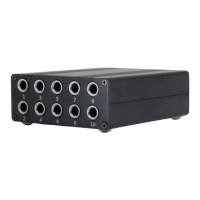
Do you have a question about the Audiofront eDrumin Series and is the answer not in the manual?
| Dimensions | Varies by model |
|---|---|
| Weight | Varies by model |
| Type | MIDI interface |
| Connectivity | USB |
| Outputs | MIDI via USB |
| Power | USB powered |
Explains powering the device using a USB charger or DC power jack, noting BOSS style jack with negative center pin.
Lists various e-drum pads from Roland, Yamaha, Alesis, etc., supported by the eDRUMin.
Details hihat controller input supporting Roland/Yamaha, expression pedals, sustain pedals, and footswitches.
Information on downloading the Control Application for Windows, macOS, and iOS from Audiofront.
Guide on enabling eDRUMin input in various MIDI applications with screenshots for setup.
Instructions for connecting drum pads using TRS connectors and the correct procedure for swapping pads.
How to load presets for drum pads using the Preset Manager icon and filters by brand and type.
Explains default note assignments and how to change them using the Note Panel or Load from Drum Map.
Details how to select the correct pad type for proper electronic wiring and note/control availability.
Explains the default transient scan settings and the need to adjust them for optimal pad performance.
Describes the topmost part of the application for selecting the device and input for editing.
Provides quick access to settings pages and useful functions like Trigger Editor and Pedal Editor.
Details the controls for adjusting trigger settings for the device's four inputs.
Allows adjustments to the pedal input on the back of the device.
Explains how each input can function as stereo, mono, or dual mono, with stereo as the default.
Determines how the input jack is wired electronically and the available notes/controls.
Toggles between Roland/Yamaha wiring and resets input settings to factory defaults.
Allows basic scan settings for pads by hitting them, with more info on the next page.
Step-by-step guide to calibrating gain, HOLD, and SCALER for dual piezo pads.
Instructions for calibrating gain and SCALERS for cymbals by hitting bow, edge, and bell.
Master gain and minimum amplitude for scanning transients, affecting velocity and trigger accuracy.
Adjusting scan time, hold duration, and decay to optimize transient capture and reduce latency.
Prevents vibrations from adjacent pads triggering unintended notes by adjusting the crosstalk control.
Adjusts velocity for articulations based on piezo amplitude and scaler values.
Fine-tunes rimshot detection and suppresses piezo sensitivity for pads with center mounted piezos.
Detects a second articulation for single piezo pads, adding a second 'Note' in the Note Panel.
Lists supported Roland cymbals for Bell Sense and how to request support for others.
Explains how to adjust Min Range for the center region and Max Range for off-center/edge portions.
Describes the four banks per input to save different sets of note assignments.
How to input MIDI notes, use Drum Map, and configure cymbal choking via notes or aftertouch.
How to assign notes for all articulations using pre-made drum maps for various software.
Uses Cubic Bezier curves to remap velocity for natural drum dynamics, especially for mesh heads.
Guides on filtering presets by brand/type and loading them to configure pad settings.
Explains which settings are applied when loading factory vs. user presets.
Steps to create, update, export, edit metadata, delete, and import user presets.
Explains pedal functions based on type and how Pedal Sensing automatically configures the input.
Resets all pedal input settings to their factory defaults.
Guide to calibrating pedals by moving them through their full range to set response.
Explains that pedals default to Hihat Mode and how to change to other modes like Basic, Drums, CC.
Importance of linking hihat pedal and cymbal trigger inputs for optimal performance.
Explains 'pedal' and 'impact' methods for processing velocity-sensitive notes from hihat control.
Details controls like Gain, Travel, xTalk, Min, and Splash Sensitivity for hihat responsiveness.
Controls like Thresh, Scaler, Expression Curve, and MIN adjust hihat openness dynamics.
How to set 'BOW' and 'EDGE' articulations to match drum sampler/module settings.
Assigning notes via Pedal Editor and ensuring CC 4 is sent for hihat controller.
Guide to configuring hihats in BFD3 using its learn feature or manual input.
Guide to selecting presets and assigning articulations for hihats in Superior Drummer 3.
How to map hihat articulations in Addictive Drums using the drum map feature.
How sustain pedals/footswitches are configured to change Note Banks by default.
Explains that pedals can be used for Bank Changes or other MIDI messages via MODE button.
Describes three ways to change banks: Selected input, Single input, or All inputs.
Controls Min and Max to specify the range of banks to use, with wrapping functionality.
How to update the eDRUMin firmware using the Control Application.
How to change the device color to rename its MIDI port and avoid confusion with multiple units.
How the iOS app communicates via camera connection kit or Network MIDI.
Remotely controlling eDRUMin devices via local network using Audio MIDI Setup.
Details the USB Host port and full-size MIDI DIN port for connecting other gear.
Explains how MIDI messages from connected devices are processed and forwarded by the eDRUMin 10.
How to connect multiple eDRUMin devices to a computer via separate USB ports.
Strategies to avoid crosstalk when connecting multiple eDRUMin devices, including physical isolation and MIDI routing.
Adjusting cymbal knob for pressure sensitivity and hihat clutch height for optimal performance.
Calibrating the hihat within the control application by pressing the pedal and adjusting for zero position.
How to send bank changes to individual, selected, or all inputs using MIDI Channel.
How Program Change message values select, increment, or decrement banks.
General tips for improving workflow, like using SHIFT, mouse wheel, and double-clicking defaults.
Ways to change note control values, including dragging, increment/decrement arrows, and double-clicking.